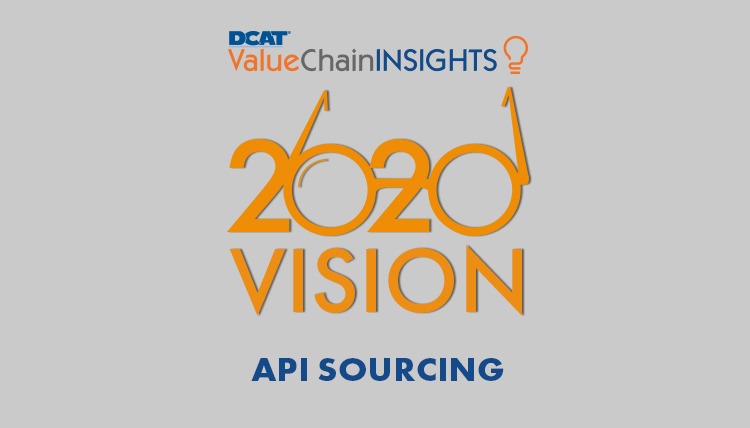2020 Vision: API Sourcing
What have been key developments thus far in 2020 impacting API sourcing, and how may that affect manufacturing networks and supply lines going forward? From plans to increase domestic drug manufacturing to shifts in product mix, DCAT Value Chain Insights takes an inside look.
Increasing domestic drug manufacturing
One of the key issues to emerge in 2020 are calls on a public policy basis to increase domestic drug manufacturing as a means to mitigate vulnerabilities in drug supply chains. This issue, although the subject of policy debate before the COVID-19 pandemic, has gained further momentum as a result of the COVID-19 pandemic. As a whole, the pharmaceutical industry has responded to the COVID-19 pandemic and mitigated potential supply disruptions, but policy debates and proposals on national and regional levels continue. Plans on how, and to what extent, to require or incentivize an increase in domestic drug manufacturing are being discussed and will be a key issue to watch for in 2020 and beyond.
Proposals in the US
The US elections, both on a Congressional and Presidential level, will play an important role in how public policy on re-shoring drug manufacturing will be shaped. Overall, there is bipartisan support from Presidential and Congressional candidates to increase domestic drug manufacturing in the US, but what specific plans, both in the extent, and how to do, have yet to be determined.
As we near the US elections being held next week (November 3, 2020), there have been some actions and move to increase domestic drug manufacturing. Most recently, in August (August 2020), President Donald Trump issued an executive order that sets forth the policy goals and authorization by certain federal departments and agencies, including the US Department of Health and Human Services (HHS) and the US Food and Drug Administration (FDA), to increase US-based production and federal procurement of essential medicines, medical countermeasures, and critical inputs. For purposes of the executive order, “essential medicines” are defined as those necessary for the US and identified by the FDA Commissioner as such. “Critical inputs” refer to active pharmaceutical ingredients (APIs), API starting materials, and other ingredients of drugs and components of medical devices that the FDA Commissioner determines to be critical in assessing the safety and effectiveness of essential medicines and medical countermeasures. Medical countermeasures are FDA-regulated products (biologics, drugs, devices) that may be used in the event of a potential public health emergency stemming from a terrorist attack with a biological, chemical, or radiological/nuclear material or a naturally occurring emerging disease.
The executive order puts forth four main policy goals. These goals are: (1) accelerate the development of cost-effective and efficient domestic production of essential medicines and medical countermeasures and have adequate redundancy built into the domestic supply chain for them; (2) ensure long-term demand for essential medicines, medical countermeasures, and critical inputs that are produced in the US; (3) create, maintain, and maximize domestic production capabilities for critical inputs, finished drug products, and finished devices that are essential to protect public safety and human health and to provide for the national defense; and (4) combat the trafficking of counterfeit essential medicines, medical countermeasures, and critical inputs over e-commerce platforms and from third-party online sellers involved in the government procurement process.
The executive order outlines authorization for federal departments and agencies to increase US-based production of essential medicines, medical countermeasures, and critical inputs and to limit federal procurement for such products to be made in the US. To mitigate supply-chain vulnerabilities, the HHS Secretary is authorized, either through revising regulations or guidance, to require certain information from drug manufacturers. This information would include: (1) the sources of finished drug products, finished devices, and critical inputs; (2) the use of any scarce critical inputs; and (3) the date of the last FDA inspection of the manufacturer’s regulated facilities and the results of such inspection.
The executive order also seeks to remove certain regulatory barriers to US-based drug production for essential medicines, medical countermeasures, and critical inputs by authorizing the HHS Secretary to review FDA regulations to determine if they may be a barrier to domestic production of these products and to advise the President whether such regulations should be repealed or amended. The executive order also provides further authorization for the HHS Secretary, through the FDA Commissioner, with regard to inspections and facility approvals and for facilitating the use of advanced manufacturing, such as continuous manufacturing and 3-D printing. Specifically, the executive order authorizes the HHS Secretary through the FDA Commissioner to do the following: (1) accelerate FDA approval or clearance of domestic producers of essential medicines, medical countermeasures, and critical inputs; (2) negotiate with countries to increase site inspections and increase the number of unannounced inspections of regulated facilities; (3) refuse admission of imports of essential medicines, medical countermeasures, and critical inputs if the facilities in which they are produced refuse or unreasonably delay an inspection; and (4) issue guidance with recommendations for the development of advanced manufacturing techniques. The executive order also authorizes the Environmental Protection Agency to take all appropriate action to identify relevant requirements and guidance documents that can be streamlined for advanced manufacturing facilities and domestic production of critical inputs by accelerating siting and permitting approvals.
While facilitating US-based drug production, the executive order does provide for certain exemptions. It allows for a broad measure to exempt actions that would not be in the public interest. It more specifically exempts products not produced in the US in sufficient and reasonably available commercial quantities and of a satisfactory quality of if their application would cause the cost of procurement to increase by more than 25%. Also, federal procurement of drugs in the US is more limited than in other Western governments, for example, only by certain federal departments and agencies, such as the Veterans Health Administration and the Department of Defense.
Industry feedback to the executive order has been mixed. The Pharmaceutical Research and Manufacturers of America (PhRMA), which represents innovator, research-based pharmaceutical companies, criticized the executive order and instead is recommending ways to enable more domestic drug production in the US without explicit mandates to do so.
The Association for Accessible Medicines (AAM), which represents generic and biosimilar developers and manufacturers, offered measured support for the executive order. In late April (April 2020), the AAM had issued its own proposal for facilitating the re-shoring of US drug production for essential medicines, A Blueprint for Enhancing the Security of the US Pharmaceutical Supply Chain, a six-element framework that lays out actions that the federal government could take to ensure a consistent supply of critical pharmaceuticals. The executive order includes certain elements of that blueprint, such as authorizing the HHS Secretary to identify a list of essential medicines to be produced in the US, but it falls short in providing financial incentives to drug manufacturers to re-shore drug manufacturing. Similar to the executive order, a key part of the AAM’s blueprint is to provide the HHS Secretary the authority to establish a list of essential medicines for the US that includes medicines deemed most critical to the US healthcare system during an HHS Secretary-designated public health emergency and/or those that, if shortages occurred, could impact US national security. Unlike the executive order, the AAM blueprint recommends that the list of essential medicines would be subject to a 60-day public comment period. Also, the AAM blueprint calls for a prioritization of essential medicines, or a high-priority list of essential medicines.
While the executive order and the AAM blueprint both specify an assessment of supply-chain vulnerabilities, the AAM blueprint is more specific by recommending that the HHS Secretary prepare a global assessment of the drug supply chain with certain key evaluations. That assessment would include: (1) the number of manufacturers of each finished dosage form and API; (2) the number of manufacturers with approved abbreviated new drug applications; (3) the market shares for manufacturers of each finished dosage form and API; (4) the volume of finished dosage form and API manufactured at each facility; and (5) the geographic location of finished dosage form and API facilities. Although the executive order seeks to increase regulatory flexibility, also a goal in the AAM blueprint, the AAM blueprint is more specific in recommending tax incentives, grants, and long-terms contracts and volume guarantees.
Plans in the EU, UK, and India
Other countries have also proposed or launched plans to reshore drug manufacturing. A reduction of reliance on offshore drug manufacturing is on the policy table in the European Union (EU). As part of the European Commission’s Pharmaceutical Strategy for Europe, which the European Commission (EC) hopes to finalize by the end of 2020, the plan calls for ways to reduce the EU’s dependency on imports of APIs, other ingredients, and pharmaceuticals from third-countries, meaning countries not part of the EU or territories of EU member states. The EC points to the EU’s dependence on APIs necessary for the production of some generic medicines, including antibiotics, oncologic medicines and basic medicines, such as paracetamol /acetaminophen, a common over-the-counter analgesic, from China and India.
In offering comments on the European Commission’s roadmap for its pharmaceutical strategy earlier this year (2020), the European Fine Chemicals Group (EFCG), which represents fine-chemical producers in Europe and which is a sector group of the European Industry Chemical Council (CEFIC), which represents European chemical manufacturers, underscored the need to repatriate pharmaceutical manufacturing back to the EU. The EFCG cited a need to reduce vulnerabilities in the pharmaceutical manufacturing value chain in the EU, particularly for generic drugs, and for starting materials and process chemicals for both innovator and generic drugs. It is proposing a selective reshoring of key building blocks of the pharma supply chain that leverages existing EU manufacturing capabilities.
Earlier this year, the UK government began developing a strategy, Project Defend, as a means to increase supply-chain resilience, including for pharmaceuticals, by identifying vulnerabilities and reducing dependence on offshore sources. Also, earlier this year, the Indian government launched a multi-year plan where financial incentives would be offered for domestic production of certain eligible products. It seeks to reduce import dependence for critical starting materials, intermediates, and APIs of those products.






